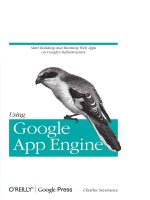OReilly office 2003 XML may 2004 ISBN 0596005385
Bạn đang xem bản rút gọn của tài liệu. Xem và tải ngay bản đầy đủ của tài liệu tại đây (11.36 MB, 1,188 trang )
•
•
•
•
•
•
TableofContents
Index
Reviews
ReaderReviews
Errata
Academic
Office2003XML
ByEvanLenz,MaryMcRae,SimonSt.
Laurent
Publisher :O'Reilly
PubDate :June2004
ISBN :0-596-00538-5
Pages :576
Thisbookexplorestherelationshipbetween
XMLandOffice2003,examininghowthe
variousproductsintheOfficesuiteboth
produceandconsumeXML.Beginningwith
anoverviewoftheXMLfeaturesincludedin
thevariousOffice2003components,Office
2003XMLprovidesquickandclearguidance
toanyonewhoneedstoimportorexport
informationfromOfficedocumentsintoother
systems.
•
•
•
•
•
•
TableofContents
Index
Reviews
ReaderReviews
Errata
Academic
Office2003XML
ByEvanLenz,MaryMcRae,SimonSt.
Laurent
Publisher :O'Reilly
PubDate :June2004
ISBN :0-596-00538-5
Pages :576
Copyright
Preface
WhoShouldReadThisBook
WhoShouldNotReadThisBook
OrganizationofThisBook
ConventionsUsedinThisBook
HowtoContactUs
SupportingBooks
UsingCodeExamples
Acknowledgments
Chapter1.MicrosoftOfficeandXML
Section1.1.WhyXML?
Section1.2.DifferentFacesofXML
Section1.3.DifferentXMLFacesofOffice
Section1.4.OpeningOfficetotheWorld
Chapter2.TheWordprocessingMLVocabulary
Section2.1.IntroductiontoWordprocessingML
Section2.2.TipsforLearningWordprocessingML
Section2.3.WordprocessingML'sStyleofMarkup
Section2.5.DocumentStructureandFormatting
Section2.7.MoreonStyles
Section2.4.ASimpleExampleRevisited
Section2.6.AuxiliaryHintsinWordprocessingML
Chapter3.UsingWordprocessingML
Section3.1.EndlessPossibilities
Section3.2.CreatingWordDocuments
Section3.3.ExtractingInformationfromWordDocuments
Section3.5.ConvertingBetweenWordprocessingMLandOtherFormats
Section3.4.ModifyingWordDocuments
Chapter4.CreatingXMLTemplatesinWord
Section4.1.ClarifyingUseCases
Section4.2.AWorkingExample
Section4.3.Word'sProcessingModelforEditingXML
Section4.5.HowtheonloadXSLTStylesheetIsSelected
Section4.7.AttachingSchemastoaDocument
Section4.9.SchemaValidation
Section4.10.DocumentProtection
Section4.12.ReviewingtheXML-SpecificDocumentOptions
Section4.14.DeployingtheTemplate
Section4.4.TheSchemaLibrary
Section4.6.MergedXMLandWordprocessingML
Section4.8.Schema-DrivenEditing
Section4.11.XMLSaveOptions
Section4.13.StepstoCreatingtheonloadStylesheet
Section4.15.LimitationsofWord2003'sXMLSupport
Chapter5.DevelopingSmartDocumentSolutions
Section5.1.What'saSmartDocument?
Section5.2.CreatingaSmartDocumentSolution
Section5.3.CodingtheSmartDocument
Section5.5.ManifestFiles
Section5.4.CodinginVB.NET
Section5.6.OtherFiles
Section5.7.AttachingtheSmartDocumentExpansionPack
Section5.9.AFewLastWordsonSmartDocuments
Section5.8.DeployingYourSmartDocumentSolution
Section5.10.SomeFinalThoughts
Chapter6.WorkingwithXMLDatainExcelSpreadsheets
Section6.1.SeparatingDataandLogic
Section6.2.LoadingXMLintoanExcelSpreadsheet
Section6.3.EditingXMLDocumentsinExcel
Section6.4.LoadingandSavingXMLDocumentsfromVBA
Chapter7.UsingSpreadsheetML
Section7.1.SavingandOpeningXMLSpreadsheets
Section7.2.ReadingXMLSpreadsheets
Section7.3.ExtractingInformationfromXMLSpreadsheets
Section7.5.EditingXMLMapswithSpreadsheetML
Section7.4.CreatingXMLSpreadsheets
Chapter8.ImportingandExportingXMLwithMicrosoftAccess
Section8.1.AccessXMLExpectations
Section8.2.ExportingXMLfromAccessUsingtheGUI
Section8.3.ImportingXMLintoAccessUsingtheGUI
Section8.4.AutomatingXMLImportandExport
Chapter9.UsingWebServicesinExcel,Access,andWord
Section9.1.WhatAreWebServices?
Section9.2.TheMicrosoftOfficeWebServicesToolkit
Section9.3.AccessingaSimpleWebServicefromExcel
Section9.5.AccessingRESTWebServiceswithVBA
Section9.7.UsingWebServicesinWord
Section9.4.AccessingMoreComplexWebServices
Section9.6.UsingWebServicesinAccess
Chapter10.DevelopingInfoPathSolutions
Section10.1.WhatIsInfoPath?
Section10.2.InfoPathinContext
Section10.3.ComponentsofanInfoPathSolution
Section10.5.UsingInfoPathDesignMode
Section10.4.AMoreCompleteExample
AppendixA.TheXMLYouNeedforOffice
SectionA.1.WhatIsXML?
SectionA.2.AnatomyofanXMLDocument
AppendixB.TheXSLTYouNeedforOffice
SectionB.1.SortingOuttheAcronyms
SectionB.2.ASimpleTemplateApproach
SectionB.4.AMoreAdvancedExample
SectionB.3.ARule-BasedStylesheet
SectionB.5.Conclusion
AppendixC.TheXSDYouNeedforOffice
SectionC.1.WhatIsXSD?
SectionC.2.CreatingaSimpleSchema
SectionC.3.SchemaParts
SectionC.4.WorkingwithXMLSchema
AppendixD.UsingDTDsandRELAXNGSchemaswithOffice
SectionD.1.WhatAreDTDs?
SectionD.2.WhatIsRELAXNG?
SectionD.3.HowDoIConvertDTDsandRELAXNGtoXSD?
Colophon
Index
Copyright©2004O'ReillyMedia,Inc.
PrintedintheUnitedStatesofAmerica.
PublishedbyO'ReillyMedia,Inc.,1005GravensteinHighway
North,Sebastopol,CA95472.
O'Reillybooksmaybepurchasedforeducational,business,or
salespromotionaluse.Onlineeditionsarealsoavailablefor
mosttitles().Formoreinformation,
contactourcorporate/institutionalsalesdepartment:(800)
998-9938or
NutshellHandbook,theNutshellHandbooklogo,andthe
O'ReillylogoareregisteredtrademarksofO'ReillyMedia,Inc.
Office2003XML,theimageofaMalaypalmcivet,andrelated
tradedressaretrademarksofO'ReillyMedia,Inc.
Manyofthedesignationsusedbymanufacturersandsellersto
distinguishtheirproductsareclaimedastrademarks.Where
thosedesignationsappearinthisbook,andO'ReillyMedia,Inc.
wasawareofatrademarkclaim,thedesignationshavebeen
printedincapsorinitialcaps.
Whileeveryprecautionhasbeentakeninthepreparationofthis
book,thepublisherandauthorsassumenoresponsibilityfor
errorsoromissions,orfordamagesresultingfromtheuseof
theinformationcontainedherein.
Preface
Formanyusers,theappearanceofOffice2003hasmeanta
slightlyupdatedversionofafamiliartool,anotherepisodein
thecontinuousdevelopmentofapopularandwidely-usedpiece
ofsoftware.Forsomeusers,however,theappearanceofOffice
2003isaheraldoftumultuouschange.ThisversionofOffice
liberatestheinformationstoredinmillionsofdocuments
createdusingMicrosoft'sOfficesoftwareoverthepast15years
andmakesitreadilyavailabletoawidevarietyofsoftware.At
thesametime,Office2003hassubstantiallyimprovedits
abilitiesforworkingwithdatathatcomesfromexternal
sources,makingitmucheasiertouseOfficeforthe
examinationandanalysisofinformationthatcamefromother
sources.
XML,theExtensibleMarkupLanguage,liesattheheartofthis
newopenness.XMLhastakenmuchoftheworldbystormsince
itspublicationin1998asaWorldWideWebConsortium(W3C)
Recommendation.XMLprovidesastandardtext-basedformat
forstoringlabeledstructuredcontent.Anenormousvarietyof
toolsforprocessing,creating,andstoringXMLhasappeared
overthelastfewyears,andXMLhasbecomealinguafranca
thatletsdifferentkindsofcomputersanddifferentkindsof
softwarecommunicatewitheachotherallwhilepreservinga
substantiallevelofhumanaccessibility.
ThisbookexplorestheintersectionbetweenOffice2003and
XMLindepth,examininghowthevariousproductsintheOffice
suitecanbothproduceandconsumeXML.Whilethisbook
generallyfocusesonOffice2003itself,somesupporting
technologieswillbeimportantpiecesoftheintegrationpuzzle.
ExtensibleStylesheetLanguageTransformations(XSLT)and
W3CXMLSchema(whichMicrosoftabbreviatesXSD,forXML
SchemaDescriptions)aretwocriticalpiecesforteaching
variouspartsofOfficeaboutthestructuresofXMLdocuments,
whileSOAP(anacronymthatnolongermeansanything)and
HTTPwillbeimportantsupportingtechnologiesfor
communicationsbetweenOfficeandotherprograms.
WhoShouldReadThisBook
Thisbookiswrittenfordeveloperswhowanttobeableto
combineOfficewithothersourcesofinformationand
informationprocessing.Forexample,youmaybeasystems
integratortryingconnectOfficetootherworkflowprocessing,
youmaybeapower-userwhowantstoanalyzeXMLdatasets
inExcelorAccess,oryoumaybeanarchivistwhoneedsto
extractcrucialinformationfromexistingOfficedocuments.
Therearemanymorepossibilitiesoutthere,ofcourse.
Thisbookiswrittenfordeveloperswhoalreadyhavean
understandingofhowtousethevariousprogramsinthe
MicrosoftOfficesuite.SomebasicinstructioninXML,XSLT,and
schema-relatedtechnologiesisprovidedintheappendixes,but
forthemostpartthisbookassumesthatyoucomewithan
understandingofXMLandrelatedtechnologies.
WhoShouldNotReadThisBook
IfallofyourworkiscompletelycontainedwithintheOfficesuite
itself,youprobablydon'tneedthisbookunlessyouhavea
particularlytrickyproblemintegratinginformationamongthe
programs.If,forinstance,youjustcreateWorddocuments
usingtemplates,youmayevenbeabletocreateXML
documentsusingthosetemplateswithoutreadingthisbook.
Similarly,developerswhocreateself-containedspreadsheets
anddatabaseswillmostlikelynotneedtolearnaboutthese
technologies.
IfyouhaveneverusedMicrosoftOfficeorXMLbefore,youmay
wanttoconsiderexploringthosetechnologiesingreaterdepth
beforereadingthisbook.
OrganizationofThisBook
ThisbookstartsinChapter1withanoverviewoftheXML
featuresincludedinthevariousOffice2003components.While
mostofthecomponentshaveXMLfeatures,theyallinteract
withXMLquitedifferently,andcomparingthestoriesofeachof
theproductsmakessensebeforeleapingintothecomponentspecificdetails.
Therestofthebookexplorestheindividualapplicationsinthe
MicrosoftOfficeSuite,asallofthemtakedifferentapproaches
toworkingwithXML.AslearningMicrosoftWord'sinternalXML
format,WordprocessingML,isacrucialfirststepfordeveloping
anyXMLapplicationsaroundit,Chapter2examineshowWord
representsitsdocumentsinXML.Chapter3explorestheuseof
XSLTtoconvertWordMLtootherformsofXML,andthen
Chapter4returnstoWordtocombineWordML,XSLT,XML
Schema,andtheWorduserinterfacetocreateenvironments
whereuserscancreatecustomXMLdocuments.Chapter5
takesalookatSmartDocuments,amuchmorelabor-intensive
butverypowerfulcombinationofWord'sfeatureswithexternal
code.
Exceloffersaslightlydifferentsetoffeaturesforanalyzingand
processingXMLandforsavingspreadsheetsasXML.Chapter6
exploreshowExcelletsusersloadandworkwithXMLdataina
varietyofvocabularies,andChapter7takesacloselookat
creatingandconsumingSpreadsheetML.
TheXMLcapabilitiesofMicrosoftAccesshavebeenenhanced
forOffice2003,andthosefeaturesaredescribedinChapter8.
Chapter9takesalookatadifferentsetofXMLfeaturesin
Office,thosespecifictoWebServices,andexamineshowtouse
theminExcel,Access,andWord.
Chapter10takesacloselookatInfoPath,anapplication
MicrosofthasaddedtotheEnterpriseversionoftheOfficesuite
specificallytoletusersinteractwithXMLandWebServices
throughaforms-basedinterface.
Thelastsectionofthebookisacollectionofappendixes,
introducingvariousXMLtechnologiesthatmaybeusefulin
workingwithOffice.Theyaren'tintendedtosubstitutefora
thoroughunderstanding,buthopefullytheywillbeenoughto
getyoustarted.
SupportingBooks
Evenifyoufeelyouarereadyforthisbook,youmaywantto
exploresomeoftheXMLtechnologiesingreaterdepththanis
possiblehere.Thefollowinglistsoffersomegoodplacesto
start.
AppendixAprovidesabrieforientationtoXML,butotherbooks
thatgointofarmoredeptharereadilyavailable.Forasolid
groundinginXML,considerthesebooks:
ErikRay,LearningXML(O'Reilly)
ElliotteRustyHarold&W.ScottMeans,XMLinaNutshell
(O'Reilly)
ElizabethCastro,XMLfortheWorldWideWeb:Visual
QuickStartGuide(PeachpitPress)
AppendixBprovidesabrieforientationtoXSLT,butmany
projectsmayrequireamoresophisticatedunderstandingof
XSLT.FormoreinformationonXSLT,trythesebooks:
MichaelFitzgerald,LearningXSLT(O'Reilly)
DougTidwell,XSLT(O'Reilly)
SalMangano,XSLTCookbook(O'Reilly)
MichaelKay,XSLTProgrammer'sReference(Wrox)
JeniTennsion,XSLT&XPath:OntheEdge(JohnWiley&
Sons)
JohnE.Simpson,XPathandXPointer(O'Reilly)
AppendixCexploresW3CXMLSchemabriefly,butthistopicis
definitelyworthyofamuchlargerbook.Somegoodoptions
include:
EricvanderVlist,XMLSchema(O'Reilly)
PriscillaWalmsley,DefinitiveXMLSchema(Prentice-Hall)
AppendixDbrieflydescribeshowtouseRELAXNG,asimpler
alternativetoW3CXMLSchema,tocreateW3CXMLSchema
files.ForamorethoroughexplanationofRELAXNG,see:
EricvanderVlist,RELAXNG(O'Reilly)
YoumayalsowanttocomplementyourXMLknowledgewith
moreinformationontherapidlygrowingworldofWebServices.
Foralotmoredetail,see:
EthanCerami,WebServicesEssentials(O'Reilly)
JamesSnell,DougTidwell,andPavelKulchenko,
ProgrammingWebServiceswithSOAP(O'Reilly)
EricNewcomer,UnderstandingWebServices:SOAP,WSDL,
andUDDI(AddisonWesley)
AlexFerraraandMatthewMacDonald,Programming.NET
WebServices(O'Reilly)
O'ReillyalsooffersacollectionofprogrammingbooksonXML
thatmayproveuseful.Theyinclude:
NielM.Bornstein,.NET&XML(O'Reilly)
BrettMcLaughlin,Java&XML(O'Reilly)
ErikT.RayandJasonMcIntosh,Perl&XML(O'Reilly)
ChristopherJonesandFredL.Drake,Jr.,Python&XML
(O'Reilly)
TherearealsomanyonlineresourcesforXML.Twoparticularly
goodplacestostartlookingareXML.comandxmlhack.com.
XML.comispartoftheO'ReillyNetwork,andcoversthelatest
newsinXMLonaweeklybasis.Forsmallerstoriesandaless
formalapproach,tryxmlhack.com.Bothhaveavarietyoflinks
tootherXMLresourcesandmailinglists.
ThereisanenormousnumberofbooksonMicrosoftOfficeand
itscomponentapplications.Mybestadviceinthisfieldistovisit
abookstoreandexamineafewbookstoseewhichbestfits
yourlearningstyleandyourinterests.(Thesameistrueofthe
XMLbooks,butthelistaboveprovidesastartingpoint.)Also,if
you'dliketoknowmoreabouthowOffice'scompetitor
OpenOffice.orghandlesXMLprocessing,seeJ.David
Eisenberg'sexcellentOpenOffice.orgXMLEssentialsat
o/.
ConventionsUsedinThisBook
Thefollowingfontconventionsareusedinthisbook:
Italicisusedfor:
Pathnames,filenames,programnames,andstylesheet
names
Internetaddresses,suchasdomainnamesandURLs
Newitemswheretheyaredefined
ConstantWidthisusedfor:
Commandlinesandoptionsthatshouldbetypedverbatim
Namesandkeywordsinprograms,includingmethod
names,variablenames,andclassnames
XMLelementtags
Constant-WidthBoldisusedforemphasisinprogramcode
lines.
Constant-WidthItalicisusedtoindicatereplaceable
argumentswithinprogramcode.
UsingCodeExamples
Thisbookisheretohelpyougetyourjobdone.Ingeneral,you
mayusethecodeinthisbookinyourprogramsand
documentation.Youdonotneedtocontactusforpermission
unlessyou'rereproducingasignificantportionofthecode.For
example,writingaprogramthatusesseveralchunksofcode
fromthisbookdoesnotrequirepermission.Sellingor
distributingaCD-ROMofexamplesfromO'Reillybooksdoes
requirepermission.Answeringaquestionbycitingthisbook
andquotingexamplecodedoesnotrequirepermission.
Incorporatingasignificantamountofexamplecodefromthis
bookintoyourproduct'sdocumentationdoesrequire
permission.
Weappreciate,butdonotrequire,attribution.Anattribution
usuallyincludesthetitle,author,publisher,andISBN.For
example:"Office2003XML,byEvanLenz,MaryMcRae,and
SimonSt.Laurent.Copyright2004O'ReillyMedia,Inc.,0-59600538-5."
Ifyoufeelyouruseofcodeexamplesfallsoutsidefairuseor
thepermissiongivenabove,feelfreetocontactusat
HowtoContactUs
Wehavetestedandverifiedtheinformationinthisbooktothe
bestofourability,butyoumayfindthatfeatureshavechanged
(oreventhatwehavemadeafewmistakes!).Pleaseletus
knowaboutanyerrorsyoufind,aswellasyoursuggestionsfor
futureeditions,bywritingto:
O'ReillyMedia,Inc.
1005GravensteinHighwayNorth
Sebastopol,CA95472
1-800-998-9938(intheU.S.orCanada)
1-707-829-0515(international/local)
1-707-829-0104(fax)
Youcanalsosendusmessageselectronically.Tobeputonthe
mailinglistorrequestacatalog,sendemailto:
Toasktechnicalquestionsorcommentonthebook,sendemail
to:
Wehaveawebsiteforthebook,wherewe'lllistexamples,
errata,andanyplansforfutureeditions.Youcanaccessthis
pageat:
/>Formoreinformationabutthisbookandothers,seetheO'Reilly
website:
Acknowledgments
FromEvanLenz
Thisprojecthasbeenawonderfulchallengeandpersonal
learningexperience.Thankyou,Simon,forinvitingmetohelp
writethisbook.You'vebeenajoytoworkwith,bothasmy
editorandasmyco-author.ThanksalsotoMaryMcRaefor
joiningusonshortnotice,bringingtolightsomeimportant
areasweweretooscaredtotouch.Iwouldalsoliketothank
technicalreviewersJeniTennisonandJeffMaggardfortheir
helpfulinsights.Jeni'scommentsinparticularwereprompt,
thorough,and(asalways)spot-on.
Thereareanumberofotherpeoplewho,directlyorindirectly,
madeitpossibleformetohelpwritethisbook.Specialthanks
goto:JamesCooperatSeattleUniversitySchoolofLaw,forso
generouslyallowingmetimetoworkonthisbook;writerslike
MichaelKayandMeroldWestphal,whoshowedmethatit's
possibletobeclearwithoutcompromisingrigor;mydad,
HerbertA.Lenz,whoalwaysencouragedmetowrite;my
grandfather,HerbertJ.Lenz,wholivedhislifeasanexampleof
whatitmeanstogiveandlovesacrificially;mybeautifulwife,
Lisa,andpreciouschildren,SamuelandMorgan,forbeing
patientandtolerantofDaddy'sextraworkinghours;and,
finally,tomyLord,whoisleadingmeonajourneyajourneyon
whichthisprojecthasbeenanimportantstep.
FromMaryMcRae
Learningtheintricaciesofanewly-developedapplicationduring
betatestingisnevereasy,andwouldnothavebeenpossible
withoutthehelpofseveralindividualsatMicrosoft,including
JeanPaoli,JoeAndreshak,BrianJones,MartinSawicki,and
AchintSrivastava.Myco-workers,DaveGiusto,RicoMcCahon,
andJeffPouliot,werenotonlysupportive,butalsoinstrumental
inhelpingtoresolvetechnicalchallenges.Specialthanksgoto
co-authorsSimonSt.LaurentandEvanLenzforinvitingmeto
beapartofthisproject,andmostimportantlytomyfamily,
SteveandHeather,fortheirloveandsupport,andforkeeping
thecoffeeflowing.
FromSimonSt.Laurent
I'dliketothankmywife,TraceyCranston,forputtingupwith
meoverthecourseofwritingthisbook.Withoutherkindness,
asusual,I'msureIwouldhavedisappearedinapuffofflame
andsmokesometimearoundthemiddleofthelastchapter.I'm
delightedtohavehadEvanLenzandMaryMcRaeascoauthors,andwouldliketothankJeniTennison,JeffMaggard,
andJeffWebbfortheirtechnicalinsightsoverthecourseof
reviewingthisbook.EddDumbillcontributedalargeportionof
AppendixAandwaskindenoughtoonlygentlychidemefor
pursuingandwritingthisbook.
Chapter1.MicrosoftOfficeandXML
MostpeoplewhouseMicrosoftOfficeseetheindividual
applicationsastoolsforgettingtheirworkdone,notasgeneralpurposeinterfacestoinformation.Sure,peopleregularly
exchangeWord,Excel,andPowerPointfilesoveremail,and
therearelotsoftimeswhenyouneedtoreusefilesyoucreated
earlier,butforthemostpartinformationcreatedinMicrosoft
OfficestaysinMicrosoftOffice,comingorgoingfromelsewhere
largelybycut-and-pasteorbyoftenimperfectfileconversions.
WiththelatestWindows-basedversionofOffice,Microsofthas
takenariskystep,openingupOfficequitedrastically.
Developers,eventhosewhoaren'tusingMicrosoftOfficeoreven
MicrosoftWindowswillbeabletoeasilyprocesstheinformation
insideofWordandExcelfiles.InsteadofjustcreatingWord
documents,userswillbeabletocreatedatafilesthatcanbe
sharedwithotherprocessesandsystems.Exceluserswillbe
abletoanalyzedatafromamuchwidervarietyofsources,and
Accessuserswillbeabletoexchangeinformationwithother
databasesandprogramsmuchmoreeasilythanbefore.Users
oftheEnterpriseEditionofOfficewillalsohaveanewformsbasedinterface,InfoPath,forworkingwithotherprograms.
AllofthesethingsarepossiblebecauseMicrosofthaschosento
integrateXMLdeeplyintothecoreofMicrosoftOffice.
1.1WhyXML?
ExtensibleMarkupLanguage(XML)definesatext-basedformat
containinglabelsandstructures.XMLlooksalotlikeHTML,the
primarylanguageusedbywebbrowsers,butXMLletsusers
anddeveloperscreatetheirownformatsratherthanlimiting
themtoasinglevocabulary.TheXML1.0specificationappeared
in1998,andawidevarietyofapplicationshaveaddedXML
functionalityorbeenbuiltaroundXMLsincethen,from
databasestostocktickerstoeditorstowebbrowsersto
inventorysystems.WhileXMLstillrequiresreadersandwriters
ofdocumentstohavesomesharedunderstandingsaboutthe
documentstheycreateandinterpret,itprovidesabasicformat
thatiseasilyprocessedinawidevarietyofdifferent
environmentsit'sevenfrequentlyhuman-readable.
Ifyou'veneverworkedwithXMLandneedtoknowthetechnicaldetails
ofhowtoreadandcreateXMLdocuments,youshouldreadAppendixA
ofthisbook.Thischapterprovidesahigh-levelviewofwhatXML
makespossibleandwhyitmakessenseforOffice,notadetailed
explanationofwhatXMLis.
MicrosofthasbeeninvolvedwithXMLforalongtime.A
Microsoftemployee,JeanPaoli(lateraproductmanagerfor
MicrosoftOffice),wasoneoftheeditorsoftheXML1.0
specificationattheWorldWideWebConsortium(W3C).
MicrosofthasbeeninvolvedwithnearlyeveryXMLspecification
attheW3Csince,andhasparticipatedinawidevarietyofXMLrelatedprojectsatotherorganizationsaswell.Microsoftbegan
workonXMLtoolsbeforethespecificationwascomplete,
buildingtheMSXMLtoolkitintoInternetExplorerandthen
expandinginto.NETandWebServicesdevelopment.Moreand
moreMicrosoftsoftwarehasXMLatitscore,andthislatest
versionofOfficejoinsalargegroupofMicrosoftapplications
usingXML.
XMLhasbeenacrucialpartofMicrosoft'sdrivetoputits
programsinmoreandmoreenvironments.XMLmakesit
possibleforMicrosoftprogramstocommunicatewithprograms
fromIBM,Sun,Oracle,andothers,andgreatlysimplifiesthe
taskofintegratingnewtoolswithcustomcode.Developerscan
buildapplicationsaroundXML,anddon'thavetoworryabout
theinternaldetailsofcomponentswithwhichtheyshareXML.
Equallyimportant,developersusingXMLdon'thavetoworry
aboutbeinglockedintoaformatthat'sproprietarytoasingle
vendor,becauseXMLisopenbydesign.Therulesforwhatis
andwhatisnotalegitimateXMLdocumentareveryclear,and
whileit'spossibletocreateXMLthatisdifficulttoread,a
combinationofstrictgrammaticalrulesandwidely-sharedbest
practicesencouragesdeveloperstocreateformatsthatareeasy
toworkworth.XMLalsoincludesfeaturesthatsupport
internationalizationandlocalization,makingitmucheasierto
consistentlyrepresentinformationacrosslanguageboundaries
aswellasprogramboundaries.
ByaddingXMLtotheMicrosoftOfficemix,Microsoftboth
makesitmucheasiertointegrateOfficewithMicrosoft
programsthatalreadyunderstandXML(likeSQLServer,
SharePointServer,andthetoolkitsinVisualStudio)andfor
developerstocreatetheirowncombinationsofMicrosoftOffice
andothersoftware.ThisallowsMicrosofttoconnecttoamuch
widervarietyofsoftwarewithoutmakingusersworryabout
whetherthey'llbeabletousethatinformationelsewhere.XML
alsoletsusersgomuchfurtherinbuildingcustomapplications
aroundMicrosoftOffice.
XMLitselfisonlyonepieceofalargerXMLpuzzle.Extensible
StylesheetLanguageTransformations(XSLT)isanXML-based
languagefortransformingoneXMLdocumentintoanother,
usingtemplates.XSLTisattheheartofmuchoftheOfficeXML
work,akeyingredientformovingfromtheXMLyouhavetothe
XMLOfficeneedsandvice-versa.Anotherspecification,W3C
XMLSchema,providesdescriptionsofdocumentstructures
whichthevariousOfficeapplicationscanuseasafoundationfor
theirprocessing.MicrosoftreferstothisasXMLSchema
Definitionlanguage,orjustXSD,buttheW3Citselfdidn't
provideanacronym.SomesourcesrefertoitasWXS(forW3C
XMLSchema),othersasXSD,someasXSDL,andsomejustas
XMLSchema.BecauseMicrosoftgenerallyreferstoitasXSD,
thisbookwilldothesame.
OneaspectofXMLdevelopmentinparticulardeservesspecial
mention,becauseMicrosofthasintegrateditintoOffice
alongsidethemoregenericXMLeditingandanalysisfunctions.
WebServices,builtontheSOAP,WSDL,andUDDI
specifications,provideasetoftoolsforcommunicatingwith
otherprogramsusingXML.Youcanstillreadandwritefiles
fromyourlocalcomputer,afileserver,orawebserver,butWeb
Servicesexposeadditionalfunctionalityofprogramslocated
anywhereonthenetwork.









